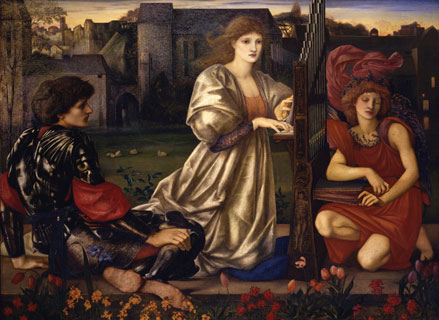
Edward Burne-Jones (1833–1898)
Le Chant d’Amour [The Love Song]
1868–73
Oil on canvas
This oil painting occupied Burne-Jones from 1868 to 1877. A consummate achievement of Victorian art, it fuses a reverence for Venetian Renaissance painting with a distinctly Aesthetic sense of the connection between music and love. Cupid, personifying Love, slowly squeezes the bellows of a portable organ played by a maiden whose music bewitches her lover, an armor-clad knight.
The composition was first created as a design for the decoration of a panel in an upright piano given to Edward and Georgiana Burne-Jones on their marriage in 1860. Georgiana was an accomplished singer whose repertoire included folk songs and medieval music as well as modern pieces; the title of the painting may derive from a traditional Breton song “Hélas! Je sais un chant d’amour / Triste ou gai, tour à tour.” The composition was also used for a watercolor of 1865 (now in the Museum of Fine Arts, Boston). Most revealing, however, is a portrait of his mistress, the sculptor Maria Zambaco (1870), in which a tiny version of Le Chant d’Amour is shown, as an illustration to an illuminated manuscript she has been reading. Burne-Jones perhaps identified himself as the lovesick knight.
The style of the work is much influenced by Venetian art, and especially the so-called Concert Champêtre in the Louvre in Paris, then thought to be by Giorgione. This richly toned pastoral scene depicted courtiers playing music outdoors, attended by female nudes. It was in an essay on “The School of Giorgione” in 1877 that the Aesthete Walter Pater coined the phrase “all art continually aspires to the condition of music.”
Le Chant d’Amour was shown in 1878 at the Grosvenor Gallery, the preeminent exhibition space for the Aesthetic Movement. In Gilbert and Sullivan’s Patience, the Aesthetic poet Bunthorne declares himself to be “a greenery-yallery Grosvenor Gallery / Foot in the grave young man,” a reference to Burne-Jones’s muted coloring and enervated male figures.
